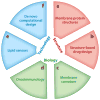Drugging Membrane Protein Interactions
- PMID: 26863923
- PMCID: PMC4968933
- DOI: 10.1146/annurev-bioeng-092115-025322
Drugging Membrane Protein Interactions
Abstract
The majority of therapeutics target membrane proteins, accessible on the surface of cells, to alter cellular signaling. Cells use membrane proteins to transduce signals into cells, transport ions and molecules, bind cells to a surface or substrate, and catalyze reactions. Newly devised technologies allow us to drug conventionally "undruggable" regions of membrane proteins, enabling modulation of protein-protein, protein-lipid, and protein-nucleic acid interactions. In this review, we survey the state of the art of high-throughput screening and rational design in drug discovery, and we evaluate the advances in biological understanding and technological capacity that will drive pharmacotherapy forward against unorthodox membrane protein targets.
Keywords: curvature sensing; drug discovery; high-throughput screening; rational design; transmembrane domains.
Figures





References
-
- Uhlén M, Fagerberg L, Hallström BM, Lindskog C, Oksvold P, et al. Tissue-based map of the human proteome. Science. 2015;347:6220. - PubMed
-
- Overington JP, Al-Lazikani B, Hopkins AL. How many drug targets are there? Nat Rev Drug Discov. 2006;5:993–96. - PubMed
-
- Rask-Andersen M, Almén MS, Schiöth HB. Trends in the exploitation of novel drug targets. Nat Rev Drug Discov. 2011;10:579–90. - PubMed
-
- Rask-Andersen M, Masuram S, Schiöth HB. The druggable genome: Evaluation of drug targets in clinical trials suggests major shifts in molecular class and indication. Annu Rev Pharmacol Toxicol. 2014;54:9–26. - PubMed
-
- Cheng AC, Coleman RG, Smyth KT, Cao Q, Soulard P, et al. Structure-based maximal affinity model predicts small-molecule druggability. Nat Biotechnol. 2007;25:71–75. - PubMed
Publication types
MeSH terms
Substances
Grants and funding
LinkOut - more resources
Full Text Sources
Other Literature Sources

